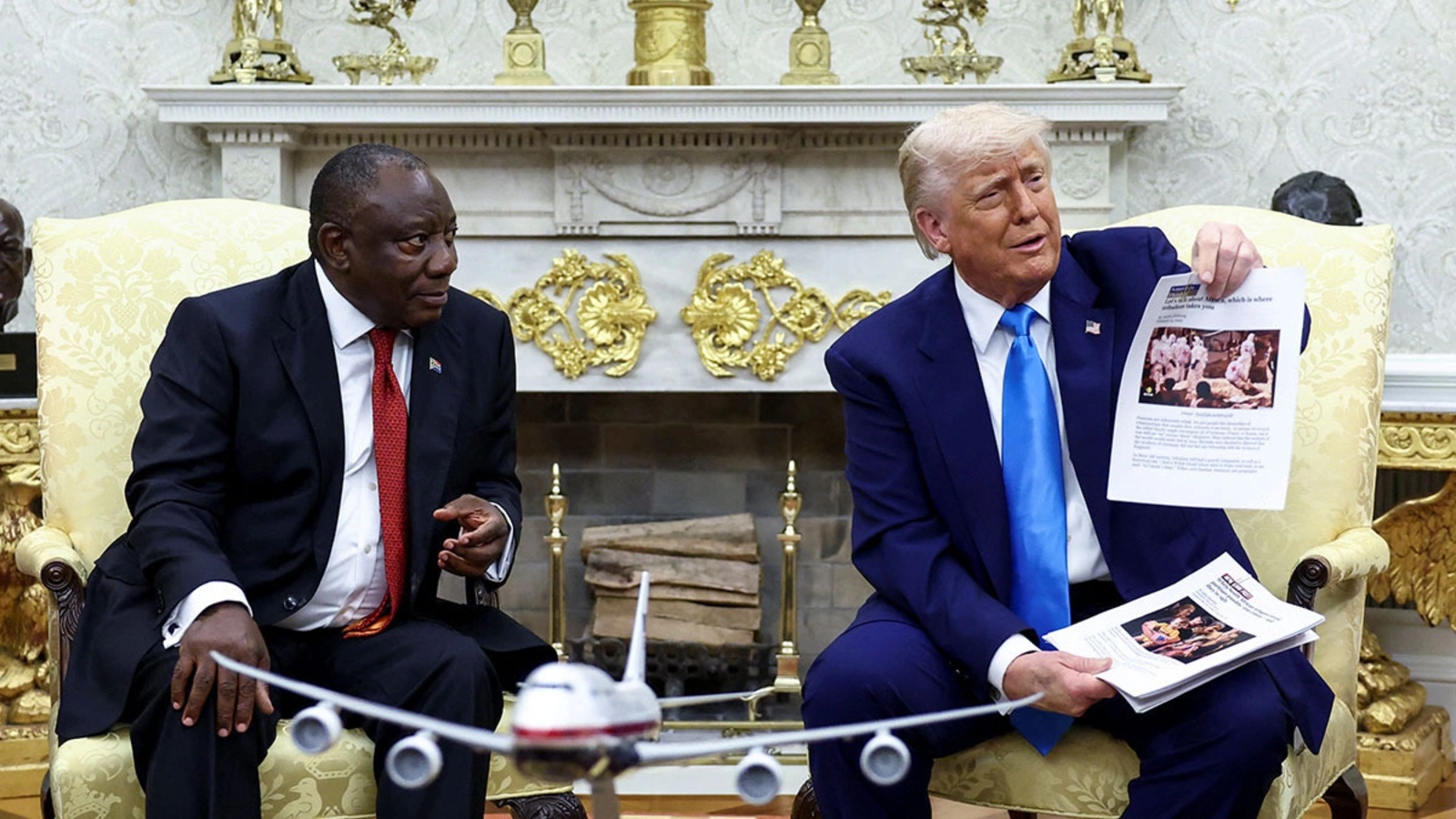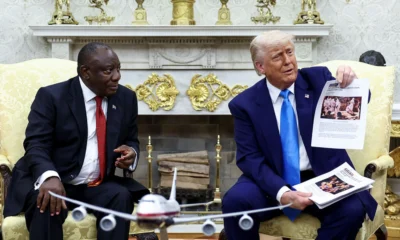Politics
China to Eliminate Tariffs on Imports from African Countries
China has announced plans to eliminate tariffs on imports from all 53 African countries with which it maintains diplomatic relations.
This policy shift aims to deepen trade relations and position China as a leading trade and investment partner for the continent.
The zero-tariff initiative, when fully implemented, would expand on a 2024 agreement that removed import duties on goods from 33 African nations classified as “least developed.”
The new policy will now include larger economies like Nigeria and South Africa, further deepening trade ties between Beijing and the continent.
However, Eswatini, the only African country that maintains diplomatic relations with Taiwan, is excluded from the deal.
Middle-income African countries with more developed manufacturing and export sectors are expected to benefit significantly from this arrangement.
Nations like Kenya, South Africa, Nigeria, Egypt, and Morocco will gain duty-free access to the Chinese market, enabling them to export a wider range of processed and value-added goods without tariff barriers.
China has also pledged additional support for smaller or less industrialized African economies, promising tailored programs to help them take advantage of the new trade benefits.
Despite the optimistic tone, trade between China and Africa continues to show a significant imbalance, with China enjoying a trade surplus of around $62 billion.
Analysts warn that unless African exports to China increase substantially, this disparity may grow.
The new tariff policy is seen as a strategic move to help rebalance trade flows and strengthen Beijing’s influence on the African continent.
This initiative follows broader economic commitments made by China, including a pledge of 360 billion yuan (approximately $50 billion) in credit lines and investments over a three-year period.
The move reflects Beijing’s ongoing efforts to cement its role as a key economic partner in Africa and offer an alternative to Western-led trade systems.
With the tariff walls coming down, African nations now face the dual challenge of scaling up production capacity and ensuring the quality of exports. If successfully harnessed, the opportunity could mark a new chapter in Africa–China relations—one defined by more equitable trade and shared prosperity.
Politics
UN Orders Urgent Probe as Survivors Detail Grisly Atrocities in Fallen Sudanese City

UN Orders Urgent Probe as Survivors Detail Grisly Atrocities in Fallen Sudanese City
In a development drawing global attention to yet another flashpoint in Africa’s worsening security landscape, the United Nations Human Rights Council on Friday ordered an urgent investigation into alleged war crimes committed during the Rapid Support Forces’ (RSF) capture of Al-Fashir, the last major Sudanese army stronghold in the Darfur region.
The resolution adopted amid mounting diplomatic pressure directs investigators to “identify, where possible” those responsible for the suspected atrocities, signalling a firm international push toward accountability as the humanitarian crisis in Sudan deepens into confirmed famine conditions.
The UN’s intervention comes nearly three weeks after the RSF seized Al-Fashir following an 18-month siege that aid agencies have described as one of the most brutal chapters of Sudan’s year-old civil war.
Since the fall of the city, nearly 90,000 residents have reportedly fled Al-Fashir and surrounding communities, according to the International Organization for Migration triggering yet another wave in a displacement crisis that has already fractured families and destabilised the region.
For those who escaped, the horrors of the RSF assault remain vivid.
At the Al-Affad displacement camp, survivor Fatheya Mohamed Hussein recounted the desperation that swallowed the city as supplies vanished.
“There was no longer Ombaz available, cattle hide was not available, we were thirsty and there was no water,” she said.
Describing the aftermath of Al-Fashir’s collapse, she added: “There were bodies in the streets… decomposed bodies… that dogs were dragging in the streets.”
Another survivor, Adam, detailed what he called systematic humiliation and violence by RSF fighters.
He recalled gunmen brandishing rifles and asserting they had “the right to kill us,” performing invasive searches and inflicting beatings.
“The searching, hitting, humiliation, and torture. Some died, others lived, and others were lost,” he told the Associated Press.
The conflict, which erupted in 2023 between the Sudanese Armed Forces and the RSF, has expanded into one of the world’s gravest humanitarian disasters—a scenario that African analysts say mirrors patterns seen in protracted conflicts from the Sahel to the Horn of Africa.
Current data from UN agencies paints a dire picture:
Famine has been officially confirmed in Al-Fashir and Kadugli, both cut off from consistent humanitarian access.
The World Food Programme warns that more than 21 million people—nearly half of Sudan’s population—now face acute food insecurity.
At least 40,000 people have been killed, while a staggering 12 million have been displaced. Aid groups fear the real figures are far higher.
UN Spokesperson Stephane Dujarric stressed that access to humanitarian corridors remains the make-or-break factor between life and death for thousands still trapped.
In areas where aid delivery has been continuous, he noted, “famine-like conditions have been reversed,” underscoring the urgent need for safe passage into conflict zones.
The newly mandated investigation aims to puncture the culture of impunity surrounding the conflict.
Both the RSF and the Sudanese Armed Forces alongside several foreign powers alleged to be providing military support now face intensified scrutiny over their roles in the atrocities unfolding across Sudan.
Analysis
Gumi, National Security and the Implications of Media Attention

Gumi, National Security and the Implications of Media Attention
By Alabidun Shuaib AbdulRahman
In Nigeria’s protracted struggle with banditry, kidnapping, and insurgency, Sheikh Ahmad Abubakar Gumi has occupied a polarising space: simultaneously a respected Islamic scholar, a self-appointed mediator, and a frequent commentator in the national media. But as Gumi’s profile has grown, so too have concerns about the unintended or possibly deliberate consequences of elevating his voice.
His persistent presence comes at a cost: legitimising non-state armed actors, undermining state institutions, and, alarmingly, projecting a version of peace-making that risks normalising criminal violence. The events of May 2025, when Saudi authorities denied him entry into Medina for Hajj despite a valid visa, offer a sharp reminder that his influence is contested even beyond Nigeria, and public discourse must scrutinise it more carefully.
Gumi’s entrée into the national conversation rests on his dual credibility: he is both a former army captain and an Islamic scholar, a combination that lends him moral authority and access. He repeatedly depicts himself as a bridge between the Nigerian state and armed bandits, arguing that military force alone is no longer sufficient.
On 6 October 2024, in an interview reported by the International Centre for Investigative Reporting (ICIR), he declared: “Today, 90 per cent of our intelligence is garbage. What we have left is just about 10 per cent.” By publicly decrying the quality of intelligence, he undermines public confidence in Nigeria’s security architecture not merely offering critique, but positioning himself as someone whose moral insight fills a gaping institutional void.
He went further in that same interview, defending his deep access to bandit hideouts by insisting he always travels with state officials: “I have never been to any den of these people without officials … I go with the police because one cannot go alone.” This claim is double-edged. On the surface, it suggests cooperation with state institutions, but it also raises serious questions about the role of an unofficial, non-state intermediary in matters that typically fall within the purview of intelligence services and the military.
Gumi’s central argument revolves around negotiation. He frequently calls for dialogues and amnesty, suggesting that social and economic neglect, not ideology alone, drives banditry. But his approach tends to frame violent criminals as aggrieved moral actors rather than lawbreakers. By giving them a quasi‑political status as if they merit a seat at the negotiation table, he risks romanticising kidnapping and terror as merely “a reaction to deprivation.”
In his public interventions, he warns that an overemphasis on force may backfire, driving some bandits toward radicalisation. Yet this very narrative can be weaponised. When militants see themselves as wronged and mediated by a respected cleric, the notion of “negotiation” becomes a path to legitimacy rather than surrender.
These concerns are not theoretical. The security picture in Nigeria remains dire. According to the 2025 Global Terrorism Index, Nigeria recorded 565 terrorism-related deaths in 2024, up from 533 in 2023, placing the country sixth globally with a score of 7.658. The report highlights that the Islamic State in the Sahel (IS‑Sahel) carried out 16 attacks in Nigeria in 2024. These are not distant or abstract threats — they are real, rapidly evolving, and increasingly sophisticated. Amid this, Gumi’s message of negotiation may sound conciliatory, but it risks diluting the urgency of counterterrorism and deflecting pressure from strengthening state institutions.
Worse, by framing himself as the only viable interlocutor, Gumi may inadvertently weaken public trust in the military and intelligence services. If the populace is encouraged to believe that official agencies are fundamentally flawed, that “90 percent” of their intelligence is worthless, then his interventions risk replacing state authority with a parallel, informal alternative. That is perilous in a democracy where violence must be constrained by transparent, accountable institutions, not individual charisma.
Compounding these concerns, Gumi’s deportation from Saudi Arabia in May 2025 highlights that even foreign powers question his role. According to the Vanguard Newspapers, he was denied entry into Medina despite holding a visa. The Guardian reported that he publicly stated on his Facebook page that “for some obvious reasons — my views about world politics, the Saudi authorities are uncomfortable about my presence … even though they have granted me a visa.”
In a statement covered by PRNigeria, he echoed that sentiment: “the Saudi authorities are uncomfortable about my presence … because of my views on world politics.” According to Premium Times, he was part of a Nigerian delegation sponsored by the National Hajj Commission, yet was turned back by Saudi immigration officials upon arrival.
This development carries symbolic weight. A major Islamic country refused him entry not because of procedural oversight, but apparently because of ideological unease. The fact that Saudi Arabia, which presides over Islam’s holiest rites, barred him suggests that his influence is not merely spiritual; it is perceived as political and potentially disruptive. From a media-perspective, that should raise alarms. If a country like Saudi Arabia, deeply attuned to global Islamic discourse, regards him as a liability, why should Nigerian media continue to treat him purely as a peacemaker?
Moreover, his deportation recontextualises his domestic credibility. He claims moral authority born of negotiating in the forest, yet his rejection by Saudi immigration projects that his theological legitimacy is contested abroad. If his presence is deemed “uncomfortable” by conservative religious gatekeepers, then domestic coverage must interrogate what exactly he stands for, rather than granting him uncritical amplification.
Part of the problem lies in how the media portrays him. Often framed as the lone compassionate voice urging dialogue, his complex reality, as someone with ideological reach, political commentary, and informal security brokerage, is underreported.
Journalists must resist treating him as simply a “bridge man” and instead ask harder questions: What outcomes have his interventions produced? How many hostages has he secured release for? How many disarmed bandits has he helped return to society? These are not just moral questions but matters of public policy and security accountability. Without that scrutiny, his narrative risks overshadowing the very institutions that are constitutionally mandated to provide security.
Beyond accountability, the media must also centre the voices of victims. In Gumi’s discourse, bandits are portrayed as victims of neglect; yet the thousands of Nigerians who have suffered kidnapping, terrorism, and displacement rarely feature in his mediated narrative. The media must ensure that reconciliation does not eclipse justice: victims’ trauma, their demand for justice, and their right to a secure society must remain core to any public conversation. Otherwise, coverage risks valorising a peace built on negotiation without consequence, rather than on accountability, deterrence, and institutional strengthening.
It is true that dialogue and community engagement are important tools in conflict resolution. But Gumi’s approach should not become synonymous with peace. By allowing him to dominate public debate unchecked, the media risks endorsing a peace that lacks democratic legitimacy. He is not a government‑appointed envoy; he acts on his own authority. That distinction matters urgently. The credibility he commands must be matched by responsibility, transparency, and a willingness to submit to public accountability.
Gumi’s exclusion from the 2025 Hajj is a pointer that, despite his domestic influence, his ideas are contested at the highest levels of the Muslim world. It suggests that his ideological reach, far from benign, may be unsettling to states deeply invested in religious orthodoxy and geopolitical stability. For Nigerian media outlets both local and national, this signals a need for recalibration. His voice should be part of the discourse, but not its centrepiece; his interventions merit coverage, but not uncritical deification.
In sum, Sheikh Ahmad Gumi’s repeated media spotlight poses a strategic and moral dilemma. His critique of Nigeria’s intelligence architecture, delivered in moral tones, may resonate with citizens frustrated by insecurity but it also undermines institutional confidence and creates a parallel narrative of justice.
The media must rethink how it covers Gumi: not to silence him, but to demand rigorous accountability, data‑driven analysis, and a balanced framing that does not sideline victims or state legitimacy.
Politics
Trump Snubs G20 Summit over ‘White Genocide’ Claims in South Africa

Trump Snubs G20 Summit over ‘White Genocide’ Claims in South Africa
U.S. President Donald Trump has announced that the United States will not attend the G20 summit in South Africa, citing what he claims is the persecution of white South Africans — allegations widely dismissed by Pretoria and independent observers.
Speaking on his social media platform Truth Social, Trump described the summit in Johannesburg as a “total disgrace”, claiming that Afrikaners are being killed and their farms confiscated illegally.
He added, “No US government official will attend as long as these human rights abuses continue.”
South Africa’s Foreign Ministry rejected the claims, calling them “regrettable and baseless”.
Spokesman Chrispin Phiri noted that Trump was “orchestrating an imagined crisis using the painful history of South Africa’s colonial past.”
“There is absolutely no evidence of white persecution in South Africa. Crime affects everyone, regardless of race. We will move on without the United States,” Phiri said.
None of South Africa’s political parties, including those representing Afrikaners have ever claimed that a genocide is occurring.
Courts in the country have similarly dismissed the so-called “white genocide” narrative as imaginary and unsubstantiated.
Earlier, Trump had suggested sending Vice President JD Vance to the summit instead of attending himself.
However, the White House later confirmed that no U.S. official will participate, signalling a diplomatic snub to Pretoria.
The G20 summit, bringing together leaders of the world’s largest economies, the European Union, and the African Union, is scheduled to hold later this month.
The bloc represents over 85 per cent of global wealth, and discussions typically focus on economic stability, trade, and global governance.
-

 Politics1 week ago
Politics1 week agoTrump Snubs G20 Summit over ‘White Genocide’ Claims in South Africa
-

 Analysis1 week ago
Analysis1 week agoTrump’s Blacklist and the Burden of Nigeria’s Image, by Boniface Ihiasota
-

 News1 week ago
News1 week agoProtesters Disrupt Preview of Multi-Million Dollar Museum in Benin City
-

 News1 week ago
News1 week agoCARICOM to Host Webinar on E-Waste Management in Renewable Energy Systems
-

 Extra1 week ago
Extra1 week agoAyomide Kashim Ibrahim: Redefining Global Finance Through Inclusion and Innovation
-

 News1 week ago
News1 week agoTrump Blasts ‘Corrupt Journalists’ After BBC Chief Resigns Over Documentary Scandal























